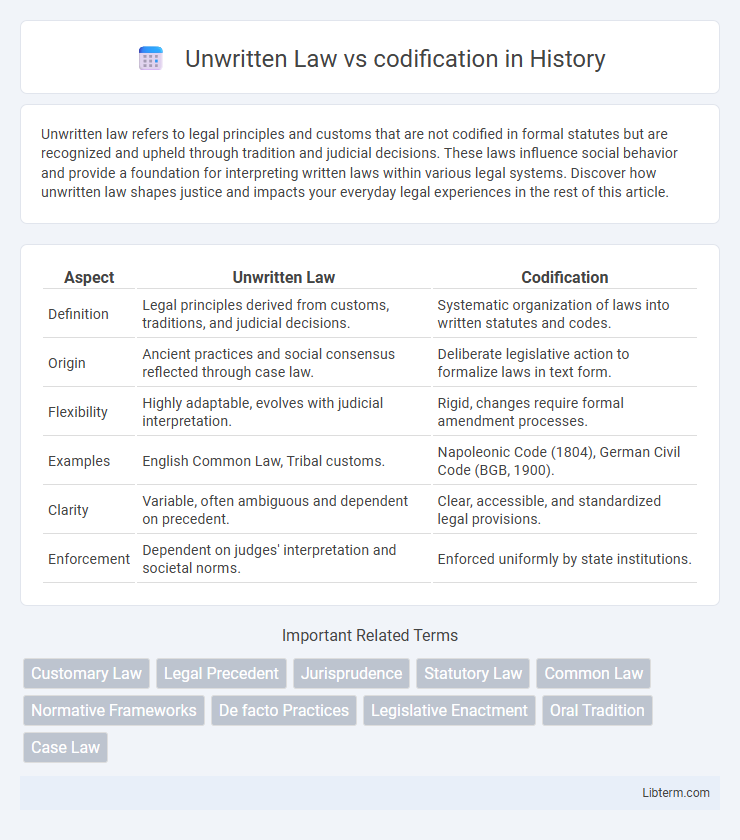Unwritten law refers to legal principles and customs that are not codified in formal statutes but are recognized and upheld through tradition and judicial decisions. These laws influence social behavior and provide a foundation for interpreting written laws within various legal systems. Discover how unwritten law shapes justice and impacts your everyday legal experiences in the rest of this article.
Table of Comparison
| Aspect | Unwritten Law | Codification |
|---|---|---|
| Definition | Legal principles derived from customs, traditions, and judicial decisions. | Systematic organization of laws into written statutes and codes. |
| Origin | Ancient practices and social consensus reflected through case law. | Deliberate legislative action to formalize laws in text form. |
| Flexibility | Highly adaptable, evolves with judicial interpretation. | Rigid, changes require formal amendment processes. |
| Examples | English Common Law, Tribal customs. | Napoleonic Code (1804), German Civil Code (BGB, 1900). |
| Clarity | Variable, often ambiguous and dependent on precedent. | Clear, accessible, and standardized legal provisions. |
| Enforcement | Dependent on judges' interpretation and societal norms. | Enforced uniformly by state institutions. |
Understanding Unwritten Law: Definition and Origins
Unwritten law consists of legal principles derived from customs, judicial decisions, and societal practices rather than formal statutes, forming the foundation of common law systems. Its origins trace back to ancient traditions and court rulings that evolved organically over time, reflecting societal values and norms before codified legislation was established. This dynamic and adaptive nature allows unwritten law to address gaps left by written statutes, ensuring legal continuity and contextual relevance.
What is Codification? Meaning and Process
Codification is the systematic arrangement and consolidation of laws into a coherent code or statute to provide clear, accessible, and organized legal rules. The process involves identifying, collecting, and restating existing laws or legal principles, often transforming customary or unwritten laws into formal written statutes. This legal method enhances consistency, predictability, and transparency in the administration of justice by converting unwritten or scattered laws into a single, authoritative legal document.
Historical Development of Unwritten Laws
Unwritten law, often rooted in customs, traditions, and judicial precedents, predates codification and evolved organically within societies to regulate behavior before formal legal systems emerged. Its historical development traces back to ancient civilizations where oral traditions and rulings by elders or monarchs formed a flexible legal framework tailored to community needs. Codification later transformed these diverse customary laws into systematic written statutes, standardizing and unifying legal principles for broader application.
Benefits of Codified Legal Systems
Codified legal systems provide clear, accessible laws that enhance predictability and consistency in judicial decisions. They facilitate legal transparency by offering detailed statutes that reduce ambiguity compared to unwritten laws derived from customs or precedents. Codification promotes uniformity across jurisdictions, enabling efficient governance and streamlined dispute resolution.
Limitations of Unwritten Law in Modern Societies
Unwritten law often lacks the clarity and predictability essential in complex, modern societies, leading to inconsistent application and uncertainty in legal outcomes. The absence of systematic codification makes it difficult to reference and enforce rights uniformly, hindering judicial efficiency and public understanding. Modern legal systems increasingly favor codification to provide definitive statutes that address evolving societal needs with precision and transparency.
Flexibility vs. Predictability: Key Differences
Unwritten law offers significant flexibility by allowing legal principles to evolve through judicial interpretations and customs, adapting to societal changes without formal amendments. Codification provides predictability by consolidating laws into clear, systematic statutes, ensuring consistent application and reducing ambiguity. The tension between flexibility and predictability defines the core distinction, with unwritten law fostering adaptability and codification promoting legal certainty.
The Role of Judicial Precedent in Unwritten Law
Judicial precedent plays a crucial role in unwritten law by establishing consistent legal principles through court decisions, which guide future judgments and fill gaps where statutory laws are absent. Unlike codification, which relies on systematically compiled statutes, judicial precedent creates a dynamic and adaptable body of law based on past rulings and judicial interpretation. This practice ensures legal stability while allowing the law to evolve organically in response to new circumstances.
Case Studies: Successful Codification Efforts
Case studies of successful codification efforts highlight the transformation of unwritten laws into structured legal codes, enhancing legal clarity and predictability. The Napoleonic Code exemplifies effective codification by systematically consolidating French civil law, influencing numerous legal systems worldwide. Similarly, the Indian Penal Code unified diverse customary laws into a coherent framework, improving legal enforcement and accessibility across India.
Unwritten Law in Contemporary Legal Frameworks
Unwritten law, rooted in customs, judicial precedents, and societal norms, plays a critical role in contemporary legal frameworks by providing flexibility and adaptability where codified statutes may lack specificity. It enables courts to interpret laws dynamically, reflecting evolving social values and addressing situations not explicitly covered by written codes. This dynamic nature of unwritten law complements codification, ensuring legal systems remain responsive and comprehensive.
Future Trends: Harmonizing Unwritten and Codified Law
Future trends in legal systems emphasize harmonizing unwritten law and codification to enhance normative clarity and adaptability. Integrating customary practices with statutory frameworks facilitates responsive governance, especially in dynamic socio-economic contexts. Emerging legal technologies and comparative law studies support this convergence by systematically aligning case law precedents with formal legal codes.
Unwritten Law Infographic

 libterm.com
libterm.com